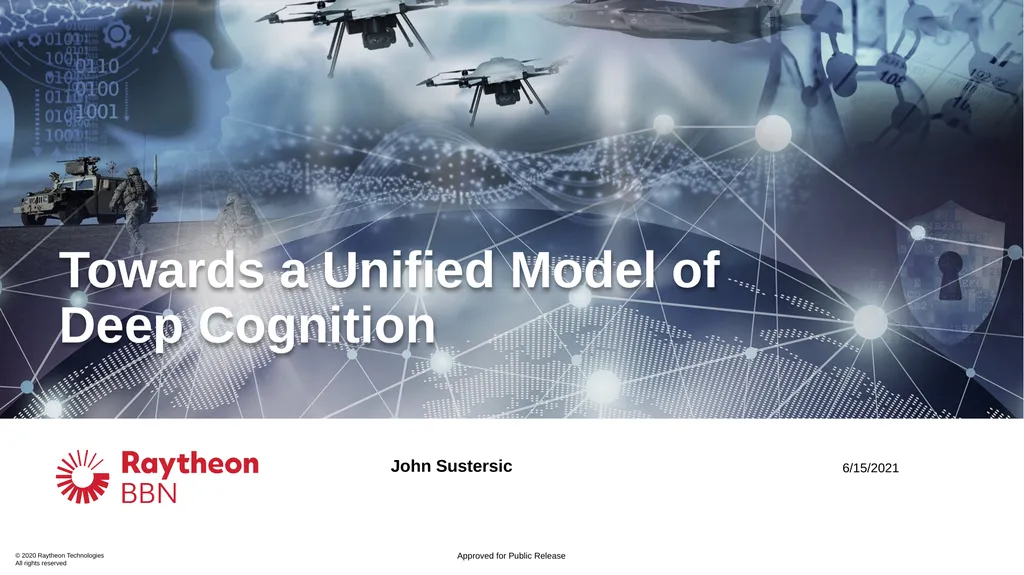6/15/2021 John Sustersic Towards a Unified Model
Author : faustina-dinatale | Published Date : 2025-11-07
Description: 6152021 John Sustersic Towards a Unified Model of Deep Cognition Approved for Public Release Lay a theoryguided foundation to a path forward for robust autonomy Provide a very brief background in cognitive architectures experiences
Presentation Embed Code
Download Presentation
Download
Presentation The PPT/PDF document
"6/15/2021 John Sustersic Towards a Unified Model" is the property of its rightful owner.
Permission is granted to download and print the materials on this website for personal, non-commercial use only,
and to display it on your personal computer provided you do not modify the materials and that you retain all
copyright notices contained in the materials. By downloading content from our website, you accept the terms of
this agreement.
Transcript:6/15/2021 John Sustersic Towards a Unified Model:
6/15/2021 John Sustersic Towards a Unified Model of Deep Cognition Approved for Public Release Lay a theory-guided foundation to a path forward for robust autonomy. Provide a (very) brief background in cognitive architectures, experiences using Soar in autonomy, and how it relates to the standard model of unified cognition. Identify key limitations of existing architectural approaches. Discuss possible ways forward. 2 Purpose Approved for Public Release Model (theoretical and/or computational) of the mind. Many models evolved over the past 5-6 decades. Soar, ACT-R, Epic, and many others. Models are often better for certain purposes than others. What is a cognitive architecture? 3 Cognitive Architecture Turing-complete: Can do anything in any architecture, however certain algorithms are *much* simpler to implement in one or other Approved for Public Release Soar Cognitive Architecture Laird, J. E., Lebiere, C., & Rosenbloom, P. S. (2017). A Standard Model of the Mind: Toward a Common Computational Framework across Artificial Intelligence, Cognitive Science, Neuroscience, and Robotics. AI Magazine, 38(4), 13-26. https://doi.org/10.1609/aimag.v38i4.2744 Approved for Public Release Esoteric, hard to learn – especially for experienced programmers in other languages. Do not often incorporate the latest computer science advances. Typing in Soar, e.g., is limited by today’s standards. Architectures ‘bake in’ assumptions that may or not apply generally or to particular use cases. Difficult to compare results from different architectures. Able to model particular aspects of cognition quantifiably better than other computational models. Principled way to express concisely algorithms that may not express as cleanly in other programming languages. E.g. Dijkstra’s algorithm is trivial in Soar, but counting is anything but... Represents a Structured AI Nuggets Coal Cognitive Architectures Ultimately, the computer is operating on bits/bytes as directed by si 5 Approved for Public Release The Standard Model Laird, J. E., Lebiere, C., & Rosenbloom, P. S. (2017). A Standard Model of the Mind: Toward a Common Computational Framework across Artificial Intelligence, Cognitive Science, Neuroscience, and Robotics. AI Magazine, 38(4), 13-26. https://doi.org/10.1609/aimag.v38i4.2744 Approved for Public Release “It depends” rules map to Soar decision layer. Partially order decision forest, where partial orders depend on context and shift relatively over time. Computational layer levered open-source heavily – CGAL, Eigen, boost, C++ 11, openCV, etc… Impedance mismatch at the Soar-C++ boundary was significant. Attentional mechanism is essential. Role based AI agents using a coarse Soar and C++ co-design software architecture of 7 Role-based Cognitive Autonomy How to be efficient designing and encoding (and













